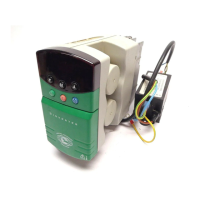
Do you have a question about the Control Techniques Dinverter A and is the answer not in the manual?
| Output Frequency | 0-400 Hz |
|---|---|
| Power Rating | 0.4kW-15kW |
| Control Mode | Vector control, V/f control |
| Braking | Dynamic braking |
| Communication | RS485, CANopen |
| Protection | Overcurrent, Overvoltage, Undervoltage, Short circuit |
Explains how to follow the guide for installing and programming the Dinverter for basic applications.
Lists advanced features like speed control, torque control, ramps, and braking covered in a separate manual.
Describes terminal mode, keypad mode, and serial communications for operating the drive.
Covers general warnings, electrical safety, system design, environmental limits, and personnel safety.
Highlights risks during installation, including electric shock, isolation devices, and stored charge.
Details EMC considerations, EU directives, and compliance standards for installation.
Provides technical data on the Dinverter's power, voltage, current ratings, and environmental specifications.
Details the specifications and installation of the optional RFI filter for EMC compliance.
Guides on temperature de-rating, motor cable length, and enclosure layout for optimal installation.
Covers AC supply, ground connections, power cables, fuses, and RFI filter setup for proper wiring.
Explains how to mount the drive and RFI filter using DIN-rail or surface mounting and how to ground the heatsink.
Introduces the drive's display and keypad for navigating menus, parameters, and status.
Details step-by-step procedures for changing parameter values, saving them, and restoring defaults.
Explains how to set motor parameters for optimal protection, safety, and performance.
Covers preparation checks and connections for terminal or keypad operation before initial setup.
Outlines procedures for verifying drive functionality and motor rotation in terminal and keypad modes.
Lists status messages, warning indications, trip codes, and troubleshooting steps for diagnosing drive issues.
Explains the two security levels (standard and user) and their states (locked/unlocked).
Details how to unlock standard security and set up/unlock user security for parameter access control.